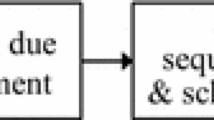Abstract
Output time prediction is a critical task to a wafer fab (fabrication plant). To further enhance the accuracy of wafer lot output time prediction, the concept of input classification is applied to the back propagation network (BPN) approach in this study by pre-classifying input examples with the self-organization map (SOM) classifier before they are fed into the BPN. Examples belonging to different categories are then learned with different BPNs but with the same topology. Production simulation is also applied in this study to generate test examples. According to experimental results, the prediction accuracy of the proposed methodology was significantly better than those of three existing approaches, case-based reasoning (CBR), BPN without example classification, and evolving fuzzy rules (EFR), in most cases by achieving a 13–46% (and an average of 30%) reduction in the root-mean-squared-error (RMSE) over the comparison basis – BPN without example classification.
Similar content being viewed by others
References
Barman S. (1998), The impact of priority rule combinations on lateness and tardiness. IIE Transactions, 30: 495–504
Chandiramani, V., Jayaseelan, R., Nathan, V. S. L. and Priya, K. S.: A neural network approach to process assignment in multiprocessor systems based on the execution time, In: Proceedings of International Conference on Intelligent Sensing and Information Processing (ICISIP 2004), 332–335, Chennai, India, 2004.
Chang P.-C., Hsieh J.-C. (2003), A neural networks approach for due-date assignment in a wafer fabrication factory. International Journal of Industrial Engineering, 10(1): 55–61
Chang, P.-C., Hsieh, J.-C. and Liao, T. W.: A case-based reasoning approach for due date assignment in a wafer fabrication factory, In: Proceedings of the International Conference on Case-Based Reasoning (ICCBR 2001), Vancouver, British Columbia, Canada, 2001.
Chang P.-C., Hsieh J.-C., Liao T.W. (2005), Evolving fuzzy rules for due-date assignment problem in semiconductor manufacturing factory. Journal of Intelligent Manufacturing, 16: 549–557
Chen T. (2003) A fuzzy back propagation network for output time prediction in a wafer fab. Journal of Applied Soft Computing, 2/3F: 211–222
Chiang J.-H. (1998) A hybrid neural network model in handwritten word recognition. Neural Networks, 11, 337–346
Foster W.R., Gollopy F., Ungar L.H. (1992) Neural network forecasting of short, noisy time series. Computers in Chemical Engineering, 16(4): 293–297
Goldberg D.E., (1989). Genetic Algorithms in Search, Optimization, and Machine Learning. Addison-Wesley, Reading MA
Hung, Y.-F. and Chang, C.-B.: Dispatching rules using flow time predictions for semiconductor wafer fabrications, In: Proceedings of the 5th Annual International Conference on Industrial Engineering Theory, Applications and Practice, Taiwan, 2001.
Jiang Y., Zhou Z.H. (2004) SOM ensemble-based image segmentation. Neural Processing Letters, 20, 171–178
Lin, C.-Y.: Shop floor scheduling of semiconductor wafer fabrication using real-time feedback control and prediction, Ph.D. Dissertation, Engineering-Industrial Engineering and Operations Research, University of California at Berkeley, 1996.
Little J.D.C. (1961) A proof of the queueing formula = λ. Operations Research, 9, 383–387
Piramuthu S. (1991) Theory and methodology – financial credit-risk evaluation with neural and neuralfuzzy systems. European Journal of Operational Research, 112, 310–321
Ragatz G.L., Mabert V.A. (1984) A simulation analysis of due date assignment. Journal of Operations Management, 5, 27–39
Tiwari M.K., Roy D. (2002) Minimization of internal shrinkage in casting using synthesis of neural network. International Journal of Smart Engineering System Design, 4, 205–214
Vig M.M., Dooley K.J. (1991) Dynamic rules for due-date assignment. International Journal of Production Research, 29(7): 1361–1377
Wang L.-X., Mendel J.M. (1992), Generating fuzzy rules by learning from examples. IEEE Transactions on Systems, Man, and Cybernetics, 22(6): 1414–1427
Weeks J.K. (1979) A simulation study of predictable due-dates. Management Science, 25, 363–373
Author information
Authors and Affiliations
Corresponding author
Rights and permissions
About this article
Cite this article
Chen, T. A Hybrid SOM-BPN Approach to Lot Output Time Prediction in a Wafer Fab. Neural Process Lett 24, 271–288 (2006). https://doi.org/10.1007/s11063-006-9027-4
Received:
Accepted:
Published:
Issue Date:
DOI: https://doi.org/10.1007/s11063-006-9027-4




